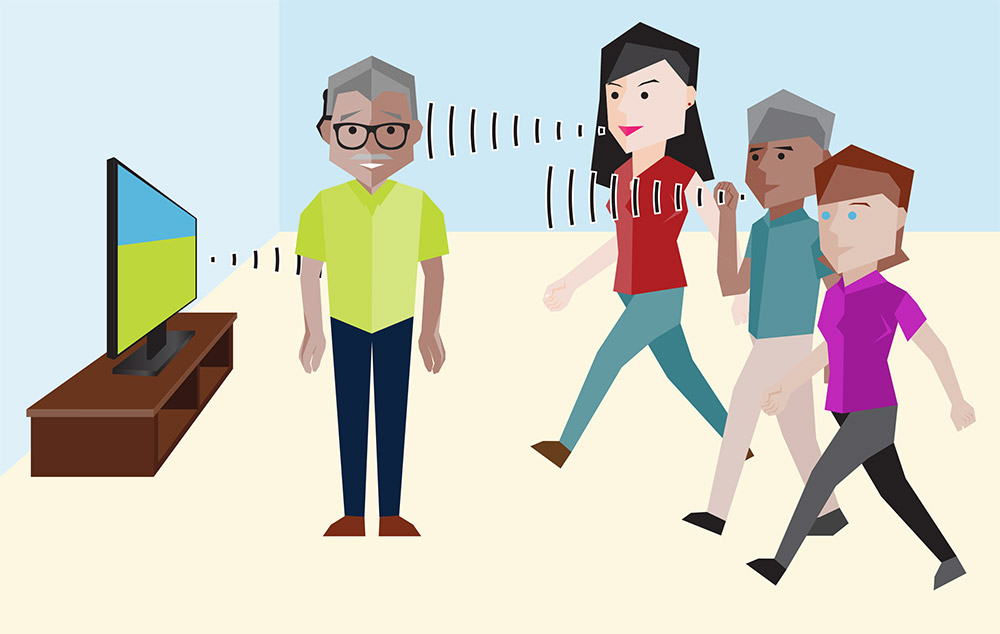
Physical Environment
Key Takeaways
Physical aspects of the environment, such as lighting or seating, may challenge communication.
Overview
Physical environments may be a cause of communication difficulties for adults with cochlear implants. Physical aspects of the environment, such as lighting, seating, echoes, reverberations, and background noise, can challenge communication.
Physical environments are distinct from social interactions, which are environments in which communication becomes difficult because of a social aspect, like a speaker having an accent or speaking too quickly. Click here to learn more about social interactions.
Knowing how to overcome a difficult physical environment can make communication less stressful and more pleasant. Watch the video below to see how Robert, an adult with a cochlear implant, overcomes a difficult physical environment.
Physical Environment
Key Takeaways
Physical environments are a large cause of communication difficulties for adults with cochlear implants.
It is important to learn more about types of physical environments, and which physical environments are specifically difficult for you.
Types of Physical Environments
Types of physical environments:
It is important to know what types of physical environments you commonly interact with and which physical environments often cause your communication difficulties. Click here to take a physical environment assessment to find out your strengths and weaknesses.
Now that you are familiar with the types of physical environments that usually cause adults with cochlear implants problems, it is time to track what environments give you problems in your daily life. Click here to download a tracking log for physical environments.
Physical Environment
Key Takeaways
There are specific strategies that may help you overcome difficult physical environments, such as planning ahead, positing strategically, changing your processor settings, asking for alternative communication, using optimal communication strategies, using assistive technologies, and when necessary, changing your environment.
Physical Environment Strategies
There are specific strategies that may help you overcome difficult physical environments.
1. Plan ahead: Before going to a new environment, research any physical aspects that may be problematic for you. Visit the types of physical environments section to learn more.
2. Position strategically: Always position away from background noise, hard surfaces, close to your communication partner, and in relation to the cochlear implant you hear best with. This could be your only cochlear implant if you are unilateral, or the cochlear implant you have had the longest if you are bilateral.
3. Change your processor settings: You should be able to manually change the volume and sensitivity to your cochlear implant on your processor or using your remote assistant. If not, you should talk to your audiologist about the specific physical environments that you are struggling with, and ask if they can change the processor settings on your cochlear implant. For example, some processors have programs for noisy environments or environments with poor acoustics.
4. Ask for alternative communication: Sometimes planning and positioning are not enough to help you hear optimally. In these cases, ask your communication partners for written or nonverbal communication. Examples of nonverbal communication could be tapping your arm to get your attention before speaking or using signals like “thumbs up” instead of speaking. It is helpful to carry a notepad in case you need written communication.
5. Use optimal communication strategies: Make sure you and your communication partners know and understand how to optimally communicate with an adult with a cochlear implant. Click here to learn more about optimal communication strategies.
6. Use assistive technologies: There is a wide variety of assistive technologies (FM systems, audio loops, etc.) that can help you overcome difficult physical environments. Click here to learn more about assistive technologies.
7. When necessary, change environments: Sometimes communicating in certain environments is incredibly difficult. If none of the above strategies help, do not be afraid to communicate to your communication partners that you need to change environments. This can range from being reseated in a noisy restaurant to asking a friend to move into a quieter room during a group gathering.
Repetition and practice are key to overcoming physical environments. Click here to download a script for dealing with difficult physical environments that you can use to practice alone or with friends and family. Building your confidence to express your needs is also an important aspect of overcoming difficult physical environments – visit the self-advocacy section to learn more.





